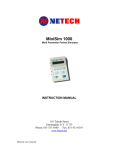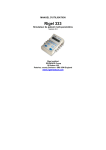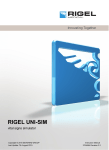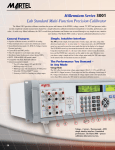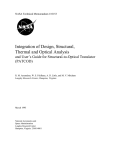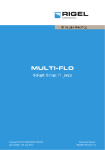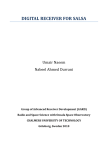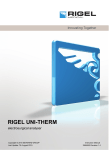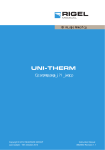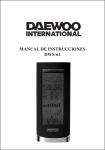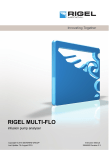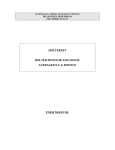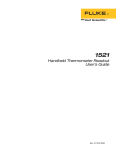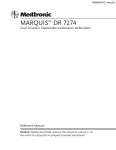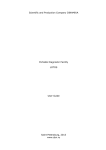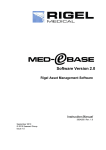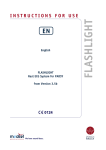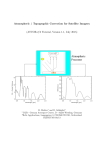Download Rigel 333 Manual
Transcript
INSTRUCTION MANUAL Rigel 333 Multi Parameter Patient Simulator Version 2.0 Rigel Medical Seaward Group 18 Bracken Hill Peterlee, County Durham • SR8 2SW England www.rigelmedical.com Dear User: We appreciate your purchase of the Rigel 333 MultiParameter Patient Simulator. Properly used, the instrument will deliver years of high performance and accuracy. This instruction manual has been designed as a tool to assist you in getting the most from your Rigel 333. In order to properly use and to maintain this instrument, please read the manual carefully. Rigel Medical, part of the Seaward Group is recognised as an innovative designer and manufacturer of advanced biomedical and industrial test instruments. Seaward Electronic Ltd is ISO 9001-2000 Registered and fully committed to a continuous improvement process. Further, we guarantee absolute satisfaction with our products. Your business is important to us and we are dedicated to providing you with the best customer and technical service possible. Please contact us should you have any questions or concerns regarding your instrument. We hope you will consider us again when you have a requirement for accurate, reliable, affordable test instruments. Sincerely, RIGEL MEDICAL 2 Copyright Copyright © 2003 by Rigel Medical. All rights reserved. No part of this publication may be reproduced or transmitted in any form other than for the purchaser’s personal use without written permission from Rigel Medical . Quality Assurance Seaward Electronic Ltd is ISO 9001-2000 Registered. This instrument was thoroughly tested and inspected according to Seaward’s ISO 90012000 quality standards and test procedures, and was found to meet those specifications when it was shipped from the factory. Warranty Rigel Medical warranties the Rigel 333 MultiParameter Patient Simulator against defects in materials and workmanship for one year from the date of original purchase. During the warranty period, we will repair or, at our option, replace at no charge a product that proves to be defective, provided you return the product shipping prepaid to Rigel Medical. This warranty does not apply if the product has been damaged by accident or misuse, or as the result of service or 3 modification by other than Rigel Medical, or if its serial number is defaced or removed. Rigel Medical reserves the right to discontinue the Rigel 333 at any time, and change its specifications, price, or design without notice and without incurring any obligation. Rigel Medical guarantees availability of service parts for 5 years after the manufacture of the unit is discontinued. The warranty is void if you elect to have the unit serviced and / or calibrated by someone other than Rigel Medical. The purchaser assumes all liability for any damages or bodily injury that may result from the use or misuse of the unit by the purchaser, his employees, agents or customers. In no event shall Rigel Medical or Seaward Electronic be liable for consequential damages Trademarks Rigel Medical and Rigel 333 are trademarks of Seaward Electronic Ltd. Any other trademark names used in this manual are only for editorial purposes and the benefit of the respective trademark owner, with no intention of improperly using that trademark. 4 TABLE OF CONTENTS General Description 6 Controls and Indicators 7 Operating Instructions 8 Baseline ECG Waveform 9 Performance Waveforms 15 Arrhythmia Waveforms 17 Automatic Testing Sequences 21 Respiration Waveforms/ Apnea 27 Blood Pressure waveforms 28 Temperature 29 Calibration 30 Specifications 30 Accessories 34 Appendix 35 5 GENERAL DESCRIPTION The Rigel 333 Multi-Parameter Patient Simulator is an advanced micro controller based instrument. It is designed to simulate patient signals of ECG, arrhythmia, invasive blood pressure, respiration, and temperature. The device also simulates square, sine, triangle, and pulse performance waveforms. The easy to operate Rigel 333 is menu driven via eight tactile feel soft keys. All functions are displayed on a two line sixteen character LCD display. The small hand held instrument is powered by one 9 Volt battery or an optional AC adapter. The Rigel 333 is CE marked and shipped with a Certificate of Calibration traceable to the NIST. The Rigel 333 is a rugged instrument that performs its simulations quickly, accurately, and with ease. 6 CONTROLS AND INDICATORS 1. 2. 3. 4. 5. 6. 7. 8. 9. On-Off Key ECG Lead Snaps LCD Display Temperature Connector Blood Pressure Connector Hi-Level ECG Output Function Keys: ‘F1’, ‘F2’, ‘F3’, ‘F4’. Arrow Keys: ‘<’ and ‘>’. Menu Key 4 5 6 7 3 8 1 2 9 7 OPERATING INSTRUCTIONS The operating menu of the Rigel 333 is arranged in a tree structure. When turned on, the micro controller initialises a test routine and displays the model and software version numbers and then switches to the Main Menu. During operation, the ‘MENU’ key returns the currently displayed menu to the previous menu. The ‘F1’, ‘F2’, ‘F3’, and ‘F4’ keys select the parameter for simulation, the specific type of parameter, and the functional characteristics of the parameter. The ‘<’ and ‘>’ arrow keys move through the available choices under the selected parameter. Basic Operating Instructions: 1. 2. 3. Connect the Rigel 333 to a patient monitor using the ECG lead snaps, correct blood pressure interface cable, and correct temperature interface cable. Turn the Rigel 333 On. Select the parameter for simulation, ‘ECG’, ’ Resp’, ‘ BP’, or ‘Temp’. 8 4. Continue to select choices under the parameter to be simulated until the functional characteristics have been chosen. 5. Each Parameter has default settings. The following are the menu sequence displays, their abbreviations, definitions, and default settings. Ecg SIMULATOR MENU Resp Bp Temp Ecg: ECG Default Setting: Normal Sinus Rhythm (NSR) at 80 BPM with Amplitude of 1 mV Resp: Respiration Default Setting: 30 BPM, Impedance 500 Ohms, Delta R 1.0 Ohm, and Apnea Off Bp: Blood Pressure Default Setting: 120/80 Dynamic Setting 0 Static Setting Temp: Temperature Default Setting: YSI 700 series set to 25°C YSI 400 series set to 25°C 9 Base Base: Perf: Arth: Aut: Aut Baseline ECG Performance Waveforms Arrhythmia Waveforms Automatic Test Sequences NSR NSR: PCR: ST: RWD: ECG Menu Perf Arth Baseline ECG PCR ST RWD Normal Sinus Rhythm Pacer Waveforms ST Segment Analysis Waveforms R Wave Detection Rate NSR/ Ampl Rate and Amplitude selections under NSR are: Rate: Ampl: 30 60 70 80 90 100 120 150 180 210 240 270 300 350 .15 0.3 0.5 1.0 10 2.0 3.0 4.0 5.0 Atr Pacer Waves Vent Selecting Atr branches to: Atr_Pcr Waves +ve AP PCR ASP +ve: Changes pacer pulse from positive (+ve) to negative ( – ve). AP: Atrial Pacer – Normal Paced Rhythm QRS with rate of 60 BPM and Pacemaker pulses with amplitudes of + 2 mV and –2 mV with duration of 0.1 ms or 2 ms with a normally paced QRS T (QRS amplitude of 1 mV, duration of 100 ms, T wave amplitude of 0.2 mV, duration of 180 ms, and Q-T interval of 350ms) PCR: Pacer Pulses Alone. Amplitude default setting of 1.0 mV and width of 1.0 ms. Widt: width selections 0.1 0.2 0.5 1.0 1.5 2.0 Ampl: amplitude selections .15 0.3 0.5 1.0 2.0 3.0 4.0 5.0 ASP: Asynchronous Pacer – Ineffective pacing. 11 A non-synchronized waveform that combines QRS waves at 30 BPM and other specifications as in AP above with pacer waves with a 0.1 ms or 2 ms width and amplitude of ± 2 mV at 80 BPM. Note: 0.1 ms pacer width for AP and ASP can only be selected by going to ‘PCR’. A selection other than 0.1 ms produces 2 ms wide pulses. Selecting Vent branches to: Vtr_Pcr Waves VP AVP VP: AVP: Ventricular Pacer at 70 BPM Atrial Ventricular Pacer at 70 BPM Selecting ST branches to: ST-SEGMENT ele dep MI TalT ST segment analysis waveforms are divided into four classes: ele: ST Elevation dep: ST Depression MI: Myocardial Infarction TalT: Tall T Wave Rejection ST _ELVATION 7% 13% 20% Flat 12 ST Elevation: 7, 13, and 20% DC levels of ST Elevation may be selected. Example: at a QRS amplitude of 1 mV, ST segments are produced at positive DC levels of 70, 130, and 200 micro volts. Waveforms may be selected with a ‘Flat’, a positive ‘+sl’, or a negative ‘-sl’ slope. The ST segment is proportional to the ECG amplitude setting. ST _DPRESION 7% 13% 20% Flat ST Depression: Identical to ST Elevation except the ST segments are now depressed. Selecting MI Myocardial Infarction branches to: Myocard_Inf Isc Inj Inf Iinf Isc: Inj: Inf: Iinf: Ischemia Injury Infarction Inferior Infarction Isc: Ischemia : Normal Sinus Rhythm (NSR) with fully inverted T waves. This is a condition of 13 reduced blood supply to the heart in a normal patient. INJ: Injury. A waveform with ST elevation of 20% with a negative slope and inverted T wave. Inf: Infarction. Normal Sinus Rhythm (NSR) with a large Q wave with the amplitude increased six times and the width increased three times compared to normal. Iinf: Inferior Infarction. A waveform with the Q wave modified as in Infarction and the ST segment elevated 7% as in ST Elevation. Selecting TalT branches to: TalT/Rate = 80 Rate Ampl An 80 BPM QRS test signal of 1 mV amplitude and 100 ms duration is generated with a T wave duration of 180 ms and Q-T interval of 350 ms. The T wave amplitude may be varied from 0 to 1.2 mV in steps of 0.1 mV . Rate: 80 BPM Amplitude: 0.0 0.1 0.2 0.3 0.4 0.5 0.6 0.7 14 0.8 0.9 1.0 1.1 1.2 Selecting RWD branches to: RWD/ Ampl Widt RWD: R Wave Detection. A QRS waveform is generated at 70 BPM with selectable width and amplitude changes. Widt: Width default setting 100 msec 70 80 90 100 110 120 10 40 50 60 Ampl: Amplitude default setting 1.0 mV .15 0.3 0.5 1.0 2.0 3.0 4.0 5.0 SIN SIN: SQR: TRI: PLS: Perf. Waves SQR TRI Sine Wave Square Wave Triangle Wave Pulse Wave Freq SIN/ Ampl 15 PLS Freq SQR/ Ampl Freq TRI/ Ampl The frequency and amplitude default settings and choices are the same for the sine, square and triangle performance waveforms. Freq: Frequency default setting 1.0 Hz 0.9 1.0 2.0 3.0 4.0 5.0 6.0 7.0 8.0 9.0 10 20 30 40 50 60 70 80 90 100 0.1 0.2 0.3 0.4 0.5 0.6 0.7 0.8 Ampl: Amplitude default setting 2.0 mV 2.0 3.0 4.0 5.0 0.1 0.2 0.5 1.0 Pulse wave default setting: A pulse wave is generated at 4 second intervals with an amplitude of 1mV and width of 20 ms. 16 Selecting Arr branches to: Atr AC Arrhythmia Menu Vent Arrhythmias are divided into Atrial, Atrial Conduction, and Ventricular waveforms. Normal Sinus Rhythm (NSR) at 80 BPM is the default waveform in this menu. Function keys select the desired arrhythmia and the MENU key clears the arrhythmia to NSR. The following are the arrhythmia definitions: Atrial: Atrial Arrhythmias SA: Sinus Arrhythmia: The ECG rate uniformly increases and decreases continuously. The pattern is cyclic with rates changing in the following order: 60, 70, 80, 90, 100, 90, 80, 70, 60 BPM. M80: Missing Beat: Normal Sinus Rhythm is th generated at 80 BPM with every 10 beat missing. AFLT: Atrial Flutter: Varying ECG rates with 12 cycles at 60 BPM for 12 seconds, 9 cycles at 90 BPM for 6 seconds, 15 cycles at 150 BPM for 6 17 seconds repeating with large P waves at 300 BPM. This corresponds to ventricular responses of 5:1 for 12 seconds, 3:1 for 6 seconds, and 2:1 for 6 seconds. AFB: Atrial Fibrillation: Irregular QRS complexes with no P waves and constantly changing R-R intervals are generated. The rate varies in a cyclic fashion at 30, 60, 70, 80 and 30 BPM with low amplitude oscillations on the baseline. PAT: Paroxysmal Atrial Tachycardia: NSR is generated at 180 BPM with inverted P waves. NODL: Junctional Premature Contraction: NSR is generated at 80 BPM with a short PR interval. The QRS starts immediately following the P wave. AC: Atrial Conduction Arrhythmias AB1: First Degree AV Block: The QRS is generated at 80 BPM, the P wave precedes the QRS by a fixed but prolonged PR interval > 0.2 seconds ( PR interval = 0.26 seconds). MB1: Second Degree AV Block: Mobitz I: Wenckebach: The QRS is generated at 80 BPM. There is a progressive lengthening of the PR interval with intermittent dropped beats. The PR intervals are 170, 230, and 310 ms. 18 MB2: Second Degree AV Block: Mobitz II: The th QRS is generated at 80 BPM with every 4 QRS missing. The PR interval is constant at 170 ms. AB3: Third degree AV Block: The P wave and QRS are independent of each other. The P wave is generated at 80 BPM and the QRS is generated at 50 BPM. RBB: Right Bundle Branch Block: A prolonged QRS (>0.12 sec) is generated at 80 BPM. The resulting QRS looks like the letter “M”. LBB: Left Bundle Branch Block: A widened QRS is generated at 80 BPM with a large wide S wave. LAH: Left Anterior Hemiblock: A QRS is generated at 80 BPM with an S wave larger than the R wave. Ventricular: Ventricular Arrhythmias PV1: Premature Ventricular Contraction 1: NSR is generated at 80 BPM. Each time the ‘F1’ function key is pressed one PVC is generated. 19 PV3: Premature Ventricular Contraction 3: NSR is generated at 80 BPM. Each time the ‘F2’ function key is pressed 3 PVCs are generated. PV6: Premature Ventricular Contraction 6: NSR is generated at 80 BPM. Each time the ‘F3’ function key is pressed 6 PVCs are generated. PV12: Premature Ventricular Contraction 12: NSR is generated at 80 BPM. Each time the ‘F4’ function key is pressed 12 PVCs are generated at different intervals. PV24: Premature Ventricular Contraction 24: NSR is generated at 80 BPM. Each time the ‘F1’ function key is pressed 24 PVCs are generated at different intervals. BGY: Bigeminy: NSR is generated at 80 BPM with every other beat as a PVC. TGY: Trigeminy: NSR is generated at 80 BPM with every third beat as a PVC. PVC: Premature Ventricular Contraction: Continuous PVCs are generated at 80 BPM. VFLT: Ventricular Flutter: Sine waves at 240 BPM are generated with irregular amplitudes. 20 VFB: Ventricular Fibrillation: A totally irregular waveform is generated with chaotic undulations of the baseline. VTC: Ventricular Tachycardia: A fast moving series of PVCs is generated at 210 BPM. PVR: Right Focal PVC: NSR is generated at 80 th BPM with every 10 beat a right focal PVC. Selecting Aut branches to: <Auto Sequence> RWD TalT PPR TAC The Automatic Test Sequence generates test waveforms in sequences according to AAMI requirements eliminating the need for the user to make numerous manual selections. The automatic test sequences are: RWD: TalT: PPR: TAC: R Wave Detection Tall T Wave Rejection Pacemaker Pulse Rejection Time for Alarm for Tachycardia The automatic sequence is initiated when the test is selected and continues until all of the test patterns 21 have been generated. During the test sequence the values generated are displayed on the LCD. At the completion of the automatic test, the display will return to its steady mode. RWD: R Wave Detection. R waves are generated with three varying parameters of amplitude, width, and rate. The three parameter values are displayed on the LCD while generated. Each test waveform is displayed for 20 seconds. The complete waveform test sequence is performed in three separate sets. Set 1: Variable Parameters Amplitude: 0.5, 2, 5 mV Width: 100, 70, 120 ms Rate: 80, 30, 210 BPM Set 1 Complete Test Sequence Amplitude (mV) 0.5 2.0 Width (ms) 100 70 120 Rate Time (BPM) (sec) 80, 30, 210 20 80, 30, 210 20 80, 30, 210 20 100 70 120 80, 30, 210 80, 30, 210 80, 30, 210 22 20 20 20 5.0 100 70 120 80, 30, 210 80, 30, 210 80, 30, 210 20 20 20 As the test progresses, the indicated heart rate displayed on the patient monitor should be within ± 10% or ± 5 BPM whichever is greater of the applied rate. Set 2: Variable Parameters Amplitude: 0.15 mV Width: 70, 120 ms Rate: 30, 210 BPM Set 2 Complete Test Sequence Amplitude (mV) 0.15 0.15 Width (ms) 70 120 Rate (BPM) 30, 210 30, 210 Time (sec) 20 20 The monitor will not respond to the waveforms in this sequence Set. Set 3: Variable Parameters Amplitude: 1.0 mV Width: 10 ms Rate: 30, 210 BPM Set 3 Complete Test Sequence 23 Amplitude Width Rate Time (mV) (ms) (BPM) (sec) 1.0 10 30, 210 20 The patient monitor will not respond to the waveforms in the Set 3 test sequence. TalT: Tall T Wave Rejection. QRS and T waves are generated with the following values: QRS: Rate 80 BPM Amplitude 1 mV Width 100 ms T Wave Duration 180 ms QT Interval 350 ms T Wave Amplitude 0.0, 0.2, 0.4, 0.6, 0.8, 1.0, and 1.2 mV . In the automatic test sequence the T Wave Amplitude steps through the changes at one minute intervals. The display indicates the T Wave Amplitude and the QRS Rate. As the T wave amplitude increases, the first value at which the patient monitor counts the T wave at 80 ± 8 BPM should be noted. This value should match the patient monitor manufacturer’s specification. PPR: Pacemaker Pulse Rejection. The test sequence cycles through normal paced rhythm 24 (AP), ineffective pacing (Asynchronous Pacing ASP), and pacemaker pulses alone (PCR). For normal pacing (AP),QRS and pacer waves are generated with the following values: QRS: Amplitude Width T wave: Amplitude Duration Q-T Interval R-R Interval Pacer: Amplitude Width 1 mV 100 ms 0.2 mV 180 ms 350 ms 1 Sec 2 mV, -2 mV 2 ms, 0.1 ms For ineffective pacing (ASP), the values of the QRS and pacer waves are the same as normal pacing except for the QRS rate that becomes 30 BPM and the pacer rate that becomes 80 BPM. During the ASP and AP test sequences the display will show the pacer amplitude, the pacer width, and the QRS rate. For pacemaker pulses alone (PCR) the values generated are: Pacer: Rate 60 BPM Width 2.0 ms, 0.1 ms Amplitude 2 mV, -2 mV 25 During the PCR test sequence the display will show the pacer amplitude, the pacer width, and the QRS rate. Each set of values in the test sequence is generated and displayed for 20 seconds. TAC: Time to Alarm for Tachycardia. The TAC test is designed to measure the time it takes for the patient monitor to alarm after the onset of ventricular tachycardia. The low and high alarms on the patient monitor should be set at 60 BPM 100 BPM before starting the test. This auto test sequence generates a QRS wave form at the rate of 80 BPM alternating with a ventricular tachycardia waveform with rates of 206 and 195 BPM and amplitudes of 1.0, 0.5, 2.0, and 4.0 mV. Each waveform is generated for 20 seconds and the display will show the amplitude and the rate of the waveform being generated. The following is the sequence of waveforms: QRS Ventricular Tachycardia Rate Amp Width Rate Amp (BPM) (mV) (ms) (BPM) (mV) 80 1 100 206 1.0 80 1 100 206 0.5 80 1 100 206 2.0 26 80 1 100 195 2.0 80 1 100 195 1.0 80 1 100 195 4.0 RESPIRATION: Select Resp in the Simulator Menu to access the Respiration selections. Rate Resp Menu Imp dR Apne Respiration waveforms are generated with four selectable rates, baseline impedances, and delta impedance variations. The Respiration default settings are: Respiration Rate 30 BPM Impedance 500 Ohms Delta Impedance 1.0 Ohm Apnea Off The value changes that may be made are: Rate: 15, 30, 60, 120 BPM. Impedance: 250, 500, 750, and 1000 Ohms. Delta Impedance: 0.1, 0.5, 1.0, and 1.5 Ohms. Apnea: Off Resp/Apne=Off Cont 12s 27 32s Off: Apnea is absent. Normal respiration waveforms are generated. Cont: Continuous Apnea. No respiration waveforms are generated. 12s: No respiration waveform is generated for 12 seconds. 32s: No respiration waveform is generated for 32 seconds. BLOOD PRESSURE: Select Bp in the Simulator Menu to access Blood Pressure selections. Dyna BP1 Menu Stat Two blood pressure waveforms are generated with selections of 12 static and 6 dynamic values. BP1 values are selected from the listed choices and BP2 values are ½ of those selected for BP1. The Dynamic pressure waveforms track the Normal Sinus Rhythm rates. The default settings for pressure values are: BP1 Dynamic: 120/80 Static: 0 BP2 Dynamic: 60/40 Static: 0 The Dynamic pressure value selections are: 100/60 120/80 28 50/10 70/30 60/20 80/40 The Static pressure value selections are: 0 5 10 20 25 30 40 50 100 150 200 300 TEMPERATURE: Select Temp in the Simulator Menu to access Temperature value selections. YSI400 Temp Menu YSI700 Temperature simulation is provided for both YSI 400 and YSI 700 standards. The temperature default setting for both is 25 degrees Centigrade. The Temperature value selections are: 25 C 37 C for both YSI 400 and YSI 700. CALIBRATION The Rigel 333 is shipped from the factory fully calibrated with a Certificate of Calibration traceable to the NIST. Annual calibration is recommended. Contact the Customer Service Department for 29 instructions for returning the instrument to Rigel Medical for either calibration or repair. SPECIFICATIONS ECG: 12 leads with independent outputs referenced to RL. NORMAL SINUS RHYTHM (NSR) ECG Rates: 30, 60, 70, 80, 90, 100, 120, 150, 180, 210, 240, 270, 300, and 350 BPM. Accuracy 0.5%. Amplitudes: 0.15, 0.3, 0.5, 1.0, 2.0, 3.0, 4.0, and 5.0 mV on Lead II. Lead 1 is 0.6 X Lead II, Lead III is 0.4 X Lead II, and Lead V is the same as Lead II. High Level: 500 X low level output on Lead II. Accuracy: 2% (1-5mV). PERFORMANCE WAVEFORMS (PERF) Sine, Square, Triangle, Pulse Frequencies: 0.1 to 0.9 in 0.1 Hz steps. 1.0 to 9.0 in 1.0 Hz steps. 10 to 100 in 10 Hz steps. Accuracy: 1% Amplitudes: 0.1, 0.2, 0.5, 1.0, 2.0, 3.0, 4.0, and 5.0 mV on Lead II. 30 Pulse: 20 ms pulse of 1mV amplitude repeated at 4 second intervals. R WAVE DETECTION (RWD) Widths: 10, 40, 50, 60, 70, 80, 90, 100, 110, and 120 ms. Amplitudes: 0.15, 0.3, 0.5, 1.0, 2.0, 3.0, 4.0, 5.0 mV on Lead II. PACER (PCR) AP: Atrial Pacer set at 70 BPM. ASP: Asynchronous Pacer – Ineffective Pacing. Pacer Amplitudes: + 2 mV and –2mV. QRS Amplitudes: 1 mV PCR: Pacer pulses alone. Pacer Widths: 0.1, 0.2, 0.5, 1.0, 1.5, and 2.0 ms. Amplitudes: 0.15, 0.3, 0.5, 1.0, 2.0, 3.0, 4.0, and 5.0 mV. VP: Ventricular Pacer set at 70 BPM. AVP: Atrial Ventricular Pacer set at 70 BPM. QRS Amplitude: 1 mV. Pacer Amplitude: -2mV. RESPIRATION Baseline Impedance: 250, 500, 750, and 1000 Ohms. Delta Impedance: 0.1, 0.5, 1.0, and 1.5 Ohms. Accuracy: 10%. Rates: 15, 30, 60, and 120 BPM. 31 Accuracy: 1% Apnea: Off, continuous, 12 seconds and 32 seconds. Lead Configuration: Leads I and II. BLOOD PRESSURE Impedance: 350 Ohms. Excitation: 2 to 16 Volts. Sensitivity: 5µV/V/mmHg. Static: 0, 5, 10, 20, 25, 30, 40, 50, 100, 150, 200, and 300 mmHg. Dynamic: 50/10, 60/20, 70/30, 80/40, 100/60, and 120/80 mmHg. Dynamic waveforms track all NSR rates. TEMPERATURE Compatibility: YSI 400 and 700 Series. Temperature: 25 and 37 degrees Centigrade. Accuracy: 2% of setting POWER REQUIRMENTS: One 9 Volt alkaline battery or optional AC adapter. PHYSICAL CHARACTERISTICS: Dimensions: 13.9 X 8.9 X 3.8 cm. Weight: 0.3 kg TEMPERATURE REQUIREMENTS: Operating: 15 to 35°C. Storage: 0 to 55°C. 32 CALIBRATED DC OUTPUTS: 10 Calibrated DC outputs from 0.04 to 2 mV. OUTPUT CONNECTIONS: Part # 303, Open Ended Pressure cable: Pressure: Pin 1 Pin 4 Pin 2 Pin 5 Single Pressure + Excitation + Signal - Signal - Excitation Pressure: Pin 3 Pin 2 Dual Pressure + Signal - Signal Part # 304, Open Ended temperature Cable: 3.5 mm Stereo Jack YSI 400 YSI 700 Tip, Ring, Shield. Tip, Ring. High Level Output: 3.5 mm Stereo Jack Signal Positive Signal Ground Input/Unused Tip Shield Ring 33 Note: Specifications are subject to change without notice. ACCESSORIES Description Part Number User Manual OPTIONAL ACCESSORIES Description Part Number Soft Carrying Case 110 VAC Adapter 220 VAC Adapter ECG Snap Studs Open Ended Temperature Cable Pressure Cables: Open Ended Space Labs Dual Space Labs Single Datascope Dual Datascope Single Hewlett Packard Dual Hewlett Packard Single Fukuda Denshi Dual Bard Dual Bard Single Mennen Medical Single Ivy Biomedical Single 34 301 302 302-220 1000 304 303 305 305-S 306 310 307 308 309 311 311-S 312 314 APPENDIX 35 Designing and Manufacturing Innovative Biomedical and Industrial Test Instruments in the United Kingdom Since 1982. • • • • • • Electrical Safety Analysers Pacemaker Analysers SPO2 Analysers NIBP Simulators Defibrillator Testers Patient Simulators For a full list of products, please order a free copy of our product catalogue online at www.rigelmedical.com Rigel Medical Seaward Group 18 Bracken Hill, Peterlee, County Durham SR8 2SW, England Phone: +44 191 5863511 • Fax: +44 191 5860227 www.rigelmedical.com 36 Rigel 333 Manual Rev 2.0 37





































